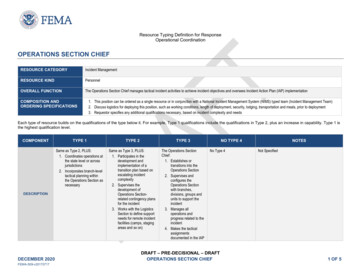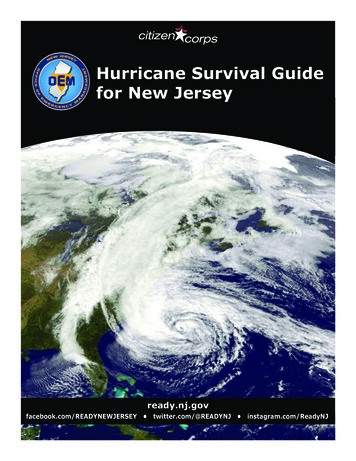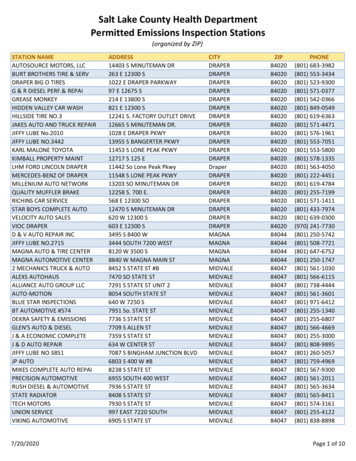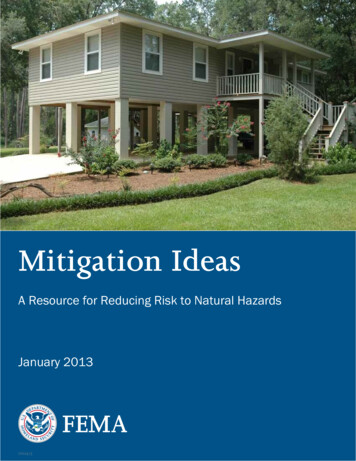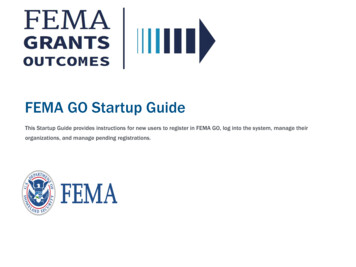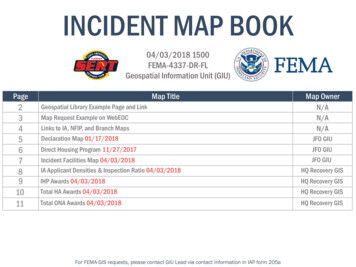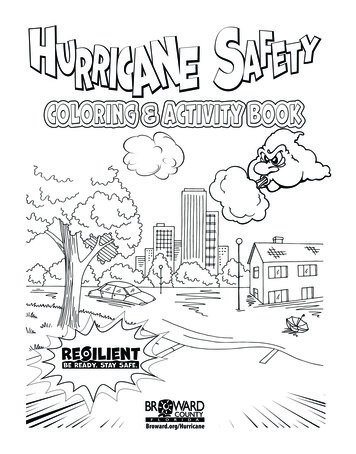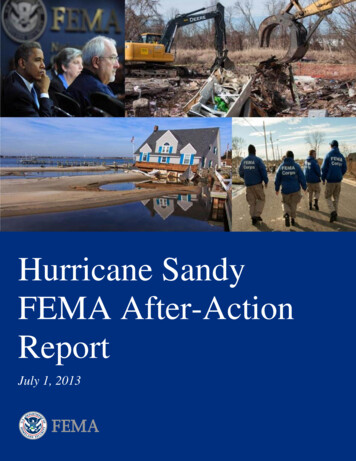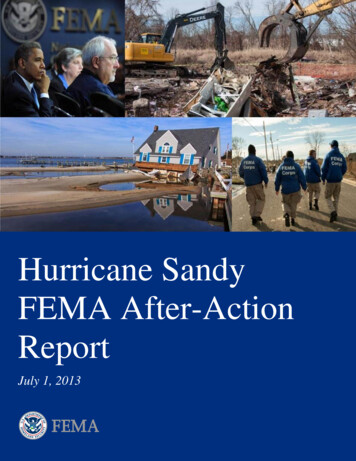
Transcription
Hurricane SandyFEMA After-ActionReportJuly 1, 2013
Letter from the AdministratorHurricane Sandy FEMA After-Action ReportTeam,Over the last four years, FEMA has made continuous progress inimproving our capabilities to support the Whole Community before,during, and after disasters. FEMA’s performance during Sandyresponse and recovery operations highlighted this progress. Wedeployed Incident Management Assistance Team (IMAT) leaderscapable of quickly identifying and solving challenges in the field. Weconducted the first mass deployment of FEMA Corps, executed theinaugural activation of the Surge Capacity Force, collected and usedcrowd-sourced information to improve our operational efficiency,and deployed the first Innovation Team comprised of WholeCommunity partners. Together, these and other key accomplishmentsdemonstrate our commitment to supporting affected communitiesand improving survivor outcomes.We also recognize where work remains to further improve. We still do not go big enough, fast enough, orsmart enough. Building on our experiences from Sandy, we will continue our efforts to prepare forcatastrophic events and not rest on past performance. We still plan for what we are capable of doing. Westill train and exercise for what we can manage. We must plan, train, and exercise even bigger to fracturethe traditional mindset. We know that it is reassuring to survivors to see government representatives whoare actively engaged in the area of impact. We are an organization in which every employee, full-time ortemporary, has an integral role in reducing the suffering of survivors and supporting communities towardrecovery.I know that many of you have worked tirelessly over the last several months. Your efforts have made adifference and are appreciated. I spend a lot of time talking with survivors and state and local officials—they cannot say enough about the dedication and compassion of FEMA employees. Each of you has a role inthis report and I am personally committed to ensuring that the opportunities to strengthen FEMA areaccomplished. Now is the time to refocus on our FEMA mission and ask how—in each and everything wedo—we can more efficiently and effectively meet the needs of disaster survivors.W. Craig FugateFEMA Administratori
Table of ContentsHurricane Sandy FEMA After-Action ReportLetter from the Administrator . iExecutive Summary . iiiIntroduction . 1Overview of the Storm, its Impacts, and the Response . 4Ensuring Unity of Effort across the Federal Response . 9Being Survivor-Centric . 17Fostering Unity of Effort Across the Whole Community . 24Developing an Agile, Professional Emergency Management Workforce . 30Conclusion . 36Appendix 1: Acronym List . 37ii
Executive Summar yHurricane Sandy FEMA After-Action ReportIntroductionSandy, the second-largest Atlantic storm on record, affected the East Coast from Florida to Maine, as well asstates as far inland as West Virginia, Ohio, and Indiana. The storm made landfall in southern New Jersey onOctober 29, 2012, battering the densely populated New York and New Jersey region with heavy rains,strong winds, and record storm surges. The storm’s effects were extensive, leaving more than 8.5 millioncustomers without power, causing widespread flooding throughout the region, and contributing to acutefuel shortages in parts of New York and New Jersey. The storm damaged or destroyed hundreds ofthousands of homes, caused tens of billions of dollars in damages, and killed at least 162 people in theUnited States.The Federal Emergency Management Agency (FEMA) coordinated a large-scale Federal response thatcontributed to the integrated, national effort to support affected states and communities. In the days beforeSandy’s landfall, FEMA worked closely with Whole Community partners— including all levels ofgovernment, private and nonprofit sectors, faith-based organizations, communities, and individuals—toprepare for the storm and anticipate survivor needs. The Agency pre-positioned commodities and assets,activated response centers, and deployed over 900 personnel ahead of Sandy’s landfall. In the initialresponse to the storm, the Agency coordinated with its partners to provide Federal resources and to developinnovative solutions to address power restoration, transportation, fuel distribution, and housing needs. Asrecovery efforts began, FEMA continued to work with its partners to assist survivors and their communities.The Agency executed one of the largest deployments of personnel in its history, delivered over 1.2 billionin housing assistance to more than 174,000 survivors, and obligated over 800 million for debris removaland infrastructure restoration.Despite these successes, the response to Sandy also revealed notable challenges in how FEMA coordinateswith its Federal partners, supports state and local officials and disaster survivors, integrates with the WholeCommunity, and prepares and deploys its workforce. Difficulties with issuing timely mission assignments,the implementation of incident management structures, and meeting survivor needs early in the responsephase are examples of challenges that emerged during Sandy. Addressing these and other issues is a nearterm priority for FEMA and its partners in order to improve response and recovery operations in futuredisasters. Ultimately, the Sandy experience demonstrated significant progress achieved in recent years, butalso confirmed that larger-scale incidents will stress the Agency’s capacity for effective response andrecovery.Strengths and areas for improvementFEMA established the Sandy Analysis Team to review all aspects of the Agency’s preparations for, immediateresponse to, and initial recovery from the storm. The Sandy Analysis Team analyzed a wide variety of dataand supporting information from FEMA and its Whole Community partners. Based on this analysis, theSandy Analysis Team identified strengths and areas for improvement organized across four overarchingthemes.Theme 1: Ensuring unity of effort across the Federal responseIn response to Sandy, FEMA coordinated a large-scale mobilization of Federal teams, supplies, and otherassets both before and immediately after landfall. The magnitude of the disaster revealed several strengthsand areas for improvement related to integrating and coordinating Federal operations.iii
Hurricane Sandy FEMA After-Action ReportStrengths and Areas for Improvement Strength: The President expedited Federal disaster declarations Strength: Using an online crisis management system to coordinate Federal response operations Area for Improvement: Integrating Federal senior leader coordination and communications intoresponse and recovery operations Area for Improvement: Coordinating Emergency Support Functions (ESFs) and Recovery SupportFunctions (RSFs) to support disaster response and recovery Area for Improvement: Refining the mission assignment process Area for Improvement: Implementing incident management structures Area for Improvement: Using planning and analysis to drive operational decision-making Area for Improvement: Ensuring continuous improvement of disaster doctrine, policies, and plansTheme 2: Being Survivor-CentricResponding to and recovering from disasters is ultimately about meeting survivors’ needs. In the wake ofSandy, FEMA established a large field presence of deployed personnel who innovated to reach moresurvivors and improve their experiences with the Agency. While these efforts eased the recovery process formany individuals, opportunities remain to better serve survivors’ needs.Strengths and Areas for Improvement Strength: Meeting survivor needs through innovation Area for Improvement: Meeting survivors’ needs during initial interactions Area for Improvement: Ensuring survivors have equal access to services Area for Improvement: Reducing the complexity of the Public Assistance programTheme 3: Fostering unity of effort across the Whole CommunityFEMA’s response and recovery operations are most effective when implemented in concert with WholeCommunity activities. During Sandy, FEMA demonstrated progress in integrating its response and recoveryefforts with the Whole Community. As the Agency prepares for the full range of potential disasters, FEMArecognizes that it must continue to improve efforts to work with community members before incidentsoccur and integrate Whole Community partners during incident response and recovery.Strengths and Areas for Improvement Strength: Integrating response and recovery efforts with nongovernmental partners Area for Improvement: Coordinating among states, localities, and tribesTheme 4: Developing an agile, professional emergency management workforceFEMA completed one of the largest personnel deployments in its history, at a time when major efforts totransform the disaster workforce were still under way. To meet Sandy staffing needs, FEMA leveragedelements of this incomplete transformation—including new sources of personnel that were established tomeet force structure requirements. The Agency also tested a new credentialing system for positions withinthat force structure. Given that the workforce transformation is incomplete, Sandy revealed challenges inFEMA’s ability to deploy sufficient numbers of credentialed personnel for a large incident. The responsealso illustrated that large-scale incidents create challenges for the Agency in areas such as lodging, travel,iv
Hurricane Sandy FEMA After-Action Reportand information technology when it is supporting a large deployed workforce. Further, large deploymentscreate challenges for maintaining steady-state functions.Strengths and Areas for Improvement Strength: Completing one of the largest and most diverse personnel deployments in FEMA history Area for Improvement: Ensuring a qualified disaster workforce Area for Improvement: Mobilizing the FEMA workforce for disaster response Area for Improvement: Supporting deployed personnel Area for Improvement: Ensuring continuity of operationsNext stepsWhile Sandy’s effects were devastating, FEMA must prepare for incidents that are larger and more complex.The strengths and areas for improvement presented in this report are crucial for improving FEMA’s abilityto respond to and recover from future incidents. In accordance with the Agency’s LL/CIP, FEMAcomponents will be responsible for implementing, tracking, and reporting on areas for improvement.FEMA has established a Continuous Improvement Working Group (CIWG), which met for the first time inFebruary 2013, to assign and monitor continuous improvement actions that reach beyond a singlecomponent or that have FEMA-wide implications.In recognition of the importance of the findings in this report, FEMA has already begun to address anumber of the areas for improvement. For example, FEMA has convened an Executive Steering Committeeto update the mission assignment process and is adding functionality to its crisis management system toincrease transparency of the status of mission assignments. The Agency also updated its Incident ManagementHandbook in January 2013 to clarify command relationships across its numerous field structures and enhancecoordination with state, local, territorial, and tribal partners. Together with the ongoing focus of the CIWG,these actions demonstrate FEMA’s commitment to learning lessons from response and recovery operations,developing solutions to identified issues, and following through on their implementation in the interest ofbetter serving disaster survivors.v
IntroductionHurricane Sandy FEMA After-Action ReportOn the evening of October 29, 2012, Sandy madelandfall in southern New Jersey. Sandy was thesecond-largest Atlantic storm on record, witheffects felt across 24 states. The storm battered theEast Coast, particularly the densely populated NewYork, New Jersey, and Connecticut region, withheavy rain, strong winds, and record storm surges,and with heavy snowfall in West Virginia and theAppalachian Mountains. In Sandy’s immediateaftermath, over 23,000 people sought refuge intemporary shelters, and over 8.5 million customerswere left without power. The storm floodednumerous roads and tunnels and blockedtransportation corridors, contributing to fuelFigure 1: Sandy's impacts were felt across 24 states.shortages across the New York metropolitan area.Ultimately, the storm caused tens of billions of dollars in damages, damaged or destroyed hundreds ofthousands of homes, and killed at least 162 people in the United States.The Federal Emergency Management Agency (FEMA) provided resources to support the WholeCommunity—including local, tribal, and state partners; nongovernmental organizations; and individualfamilies—in its response to the storm. In the days before the storm hit, the Agency worked with threatenedcommunities to develop incident response plans and pre-position supplies to support response efforts.Immediately after the storm, FEMA coordinated Federal resources to assist Whole Community life-savingmeasures and stabilization efforts. The Agency moved to meet long-term survivor needs, working withstate, tribal, local, public, disability community, and private partners on housing solutions, as well asproviding over 1.2 billion in aid.Sandy response and recovery efforts demonstrated key strengths. The President expedited disasterdeclarations, speeding Federal response and recovery support to affected states, localities, and tribes. Inaddition, FEMA and its Federal partners used an online crisis management system to facilitate unity of effortacross the Federal response. FEMA also identified and implemented innovative approaches and workedclosely with Whole Community partners to support response and recovery operations. Finally, FEMA drewupon a variety of new programs to complete one of the Agency’s largest and most diverse deployments ofpersonnel to date.Despite these strengths, the scale and severity of the storm created significant challenges regardingrestoration of power and transportation systems, fuel availability, and housing. Through these challenges,FEMA identified opportunities to further improve how it coordinates with Federal partners, serves disastersurvivors, integrates with Whole Community partners, and prepares and deploys its workforce.1
Hurricane Sandy FEMA After-Action ReportIn January 2013, Congress passed the SandyRecovery Improvement Act of 2013 (part ofthe broader Disaster Relief AppropriationsAct), which the President then signed.Legislative changes allow FEMA—and thestate, local, and tribal governments itsupports—greater flexibility in administeringassistance programs, improving the Nation’sability to efficiently respond to and recoverfrom disasters.While the effects of Sandy were devastating,FEMA recognizes that it must plan andprepare for even more severe events. FEMA iscommitted to continuous improvement andensuring that future response and recoveryoperations incorporate the lessons learnedand best practices identified during Sandy.Sandy Recovery Improvement ActOn January 29, 2013, President Obama signed into law theSandy Recovery Improvement Act of 2013 (P.L. 113-2)(SRIA). The law authorizes several significant changes to theway FEMA may deliver disaster assistance under a variety ofprograms. These programs include Public Assistance,Permanent Work procedures, debris removal, HazardMitigation, dispute resolution, Federal Assistance toIndividuals and Households, adds additional reviews forcertain types of projects, and amends the Stafford Act toprovide for an option for the Chief Executive of a federallyrecognized Indian tribe to make a direct request to thePresident for a major disaster or emergency declaration.FEMA is currently working to implement the changesauthorized by SRIA.This report was written following response and initial recovery efforts to Hurricane Sandy. Anyrecommendations or findings that result from other interagency Sandy-related efforts will continue to bereviewed.Scope of the reportAt the direction of FEMA Administrator Craig Fugate, the Agency established the Sandy Analysis Team toreview all aspects of the Agency’s preparations for, immediate response to, and initial recovery from thestorm. This report contains the findings of that review. While FEMA coordinates disaster response andrecovery efforts across the Federal Government and works closely with non-Federal Whole Communitypartners, this report focuses on identified strengths and areas for improvement within FEMA. The analysesdetailed in the report concentrate on FEMA activities in New York and New Jersey, where the scale andseverity of Sandy’s impacts most stressed the Agency’s capabilities. By examining the events in these states,the Agency can identify where and how it must improve.Report methodologyThe Sandy Analysis Team, as the coordinator of the Sandy after-action review, examined a wide variety ofinput from FEMA and its Whole Community partners. The team’s approach included: Developing an event chronology that catalogs over 1,500 specific decisions, actions, and events relatedto the response to- and initial recovery from the storm; Developing and analyzing 44 quantitative datasets that indicate how the storm’s impact, as well as theNation’s response and recovery, evolved over time; Analyzing 43 FEMA component submissions on lessons learned from Sandy, and supporting efforts todevelop component-specific after-action reports and corrective action plans; Interviewing 215 personnel, including FEMA headquarters officials, field and regional personnel,representatives of other Federal departments and agencies, and state and local officials; Issuing a survey to over 8,600 FEMA and U.S. Department of Homeland Security (DHS) Surge CapacityForce (SCF) personnel who deployed to support the Sandy response and recovery, and analyzing the2,641 responses received; Coordinating 11 working groups with 121 representatives from across FEMA components thatreviewed preliminary findings; and Inviting Whole Community partners to share their experiences and lessons learned through FEMA’sLessons Learned Information Sharing (LLIS.gov) system.2
Hurricane Sandy FEMA After-Action ReportThe Sandy Analysis Team reviewed and analyzed all of these sources to identify strengths and areas forimprovement.Organization of the reportThis report begins with an overview of thestorm and the response and recovery efforts.The report is then organized according to thefollowing four themes: Ensuring unity of effort across the Federalresponse; Being survivor-centric; Fostering unity of effort across the WholeCommunity; and Developing an agile, professionalemergency management workforce.Core capabilitiesThe 2011 National Preparedness Goal establishes 31 corecapabilities that are most essential to the Whole Communityin order to prevent, protect against, mitigate the effects of,respond to, and recover from the types of incidents that posethe greatest risk to the Nation.Because integrating and coordinating the Whole Communityis such an important part of FEMA’s role in disaster responseand recovery efforts, many of the report’s identifiedstrengths and areas for improvement pertain to theOperational Coordination core capability. Other relevantcore capabilities referenced include: Planning; PublicInformation and Warning; Infrastructure Systems; EconomicRecovery; and Housing.For each of these themes, this reportidentifies strengths and areas for improvement. Throughout the report, call-out boxes highlight WholeCommunity innovations that emerged during Sandy.1 These innovations demonstrate how FEMA responseand recovery operations work in concert with the activities of the Whole Community.1References to specific Whole Community partners do not constitute endorsements of the organization or its services.3
Hurricane Sandy FEMA After-Action ReportOver view of the Storm, its Impacts, and the ResponseSandy’s pathSandy was the 18th named storm ofthe 2012 Hurricane Season and the10th hurricane. The storm formed inthe southwestern Caribbean Sea onOctober 22 and became a hurricanetwo days later. After passing throughCuba as a Category 2 hurricane onOctober 25, Sandy weakened to aCategory 1 hurricane and movednorth over the Atlantic Ocean,parallel to the southeastern UnitedStates. As the storm moved north, itmerged with an arctic cold front.This steered it to the northwest andgave Sandy its extremely broad windfield. The storm produced severeflooding along the Atlantic Coast,blizzard-like conditions in theAppalachian Mountains (with morethan two feet of snow in areas ofFigure 2: Sandy made landfall near Atlantic City, NJ on October 29, 2012West Virginia, Virginia, Maryland,as a post-tropical cyclone after traveling up the southeastern U.S. coastas a Category 1 hurricane.and North Carolina), and extremewinds and localized flooding in the coastal areas of the Great Lakes.On the morning of October 29, the combination of a high-pressure pattern over New England and a midlevel trough moving east from the Midwest redirected the storm’s trajectory toward southern New Jersey.Sandy made landfall later that evening near Atlantic City, New Jersey, as a post-tropical cyclone withhurricane-force winds of up to 80 miles per hour. The storm weakened as it moved west across southernPennsylvania on October 30. By November 1, most of the wind and rains from the storm’s remnants haddiminished across the affected states. Figure 2 shows the storm’s path from formation to landfall.With tropical storm–force winds extending 580 miles from the center, Sandy was the second-largestAtlantic storm on record. The storm affected the East Coast from Florida to Maine, as well as states as farinland as West Virginia, Ohio, and Indiana. Sandy particularly lashed the New York and New Jersey coastswith heavy rain, winds, and a record storm tide that approached 14 feet in some areas. The storm’s impactwas intensified because it made landfall in the most populated region of the country—a region thatincludes critical infrastructure vital to the Nation’s economy.Preparations for SandyIn the days leading up to Sandy’s landfall, FEMA and the Whole Community made extensive preparationsfor the storm. FEMA based pre-landfall decisions both on the predictions of the storm’s track and intensity,as well as on requests from states expecting to be impacted. Prior regional catastrophic planningcoordination between FEMA and the impacted states facilitated these decisions. Ultimately, over 900 FEMApersonnel pre-deployed and were on the ground when Sandy made landfall. Key pre-landfall actionsincluded: 4Establishing Incident Support Bases in Massachusetts and New Jersey, as well as five Federal StagingAreas in New York, to pre-position commodities, generators, and communications vehicles (prestaged commodities included 892,000 liters of water, 561,000 meals, 11,900 blankets and cots,183 generators, 30 infant and toddler kits, 2 Durable Medical Equipment [DME] kits, and 2Consumable Medical Supplies [CMS] kits);
Hurricane Sandy FEMA After-Action Report Deploying liaison officers (LNOs) and 13 Incident Management Assistance Teams (IMATs) toemergency operations centers in Connecticut, Delaware, the District of Columbia, Maine,Maryland, Massachusetts, New Jersey, NewYork, Pennsylvania, Rhode Island, Virginia,Emergency and major disaster declarationsand Vermont;The Robert T. Stafford Disaster Relief and EmergencyActivating the National ResponseAssistance Act authorizes the President—actingCoordination Center (NRCC)—the multithrough FEMA—to issue emergency or major disasterdeclarations. Emergency declarations allow FEMA toagency coordination center that coordinatesprovide Federal assistance for emergency measuresoverall Federal support for major disastersthat protect property, public health, and safety. Majorand emergencies—to a Level 1, its highestdisaster declarations make available additionallevel, as well as activating all Emergencyrecovery assistance that Federal agencies provide toSupport Functions (ESFs) and the Regionalstate, local, and tribal governments, survivors, andResponse Coordination Centers (RRCCs) forcertain nonprofit organizations.FEMA Regions I, II, III, and IV; Deploying nine National Urban Search and Rescue Task Forces, including eight with waterbornerescue capabilities; Deploying all six Mobile Emergency Response System (MERS) detachments—which providedeployable, command, control, and incident communications capabilities—to 11 states across theEast Coast; Pre-staging 165 ground ambulances and associated medical teams; and Deploying three Regional Disability Integration Specialists (RDISs) to coordinate with state andlocal partners and the disability community.Coordinated response operationsBefore the storm made landfall, thePresident authorized emergencydeclarations for Connecticut, the District ofColumbia, Maryland, Massachusetts, NewJersey, and New York. On the day ofSandy’s landfall, the President authorizedadditional emergency declarations forDelaware, Pennsylvania, Rhode Island,Virginia, and West Virginia; and for NewHampshire the next day. The Presidentauthorized major disaster declarationsshortly after midnight on October 30 forNew York and New Jersey, and thefollowing afternoon for Connecticut. ThePresident subsequently authorized majorFigure 3: The Army National Guard prepares todisaster declarations for nine other statesprovide supplies to survivors in Far Rockaway, NY.and the District of Columbia. Thesedeclarations made Federal assistance available to communities and survivors in the impacted regions.While FEMA coordinates Federal response and recovery activities, the Federal Government is only part ofthe broader efforts of the Whole Community—including all levels of government, private and nonprofitsectors, faith-based organizations, communities, and individuals. FEMA deployed significant numbers ofpersonnel, both before and after the storm made landfall, to support response and recovery efforts. At thepeak of response and initial recovery efforts, more than 17,000 Federal personnel—including more than7,500 FEMA staff—were deployed. In addition, states deployed over 11,000 National Guard personnel inthe impacted areas.In the first 72 hours of response operations, FEMA focused efforts on supporting first responders to savelives, maintain safety, restore power, and stabilize communities with the FEMA Administrator emphasizing5
Hurricane Sandy FEMA After-Action Reportresponse priorities as: people, power restoration, points of distribution for commodities, and pumpingflooded tunnels. On October 29, the day Sandy made landfall, FEMA issued over 6.3 million in missionassignments to Federal partners, directing them to provide assets and services to support state, local, andtribal efforts. Federal assets and services included communications system restoration, debris removal,aerial imaging and surveillance, and health and medical care.As the response unfolded, FEMA continued to provide needed commodities to the affected areas. ByNovember 11, FEMA had shipped 20 million liters of water, 16 million meals, 1.7 million blankets,79,000 cots, 138,000 tarps, 568 generators, 105 infant and toddler kits (capable of serving a total of 1,050for one week), 5 DME kits (capable of serving a total of 1,250 survivors), and 4 CMS kits (capable ofserving a total of 1,000 survivors for one week).Infrastructure restorationSandy disrupted the energy and transportation infrastructure throughout the mid-Atlantic region. Thestorm left 8.5 million customers without power, severely damaged public transportation systems, andcontributed to a significant fuel shortage along the East Coast. In support of an aggressive power-restorationeffort, the President approved a 100 percent cost share, from October 31 to November 14, for emergencypower restoration work performed by state, local, and tribal governments. FEMA coordinated Federalresources to assist state, local, and tribal authorities, including the following examples: Energy: At the President’s direction, FEMA established the Energy Restoration Task Force onOctober 31 to better coordinate Federal, state, tribal, local, and private sector efforts to restorepower as quickly as possible. Working through the Task Force, the U.S. Department of Defense(DOD) U.S. Transportation Command airlifted 229 power-restoration vehicles and 487 personnelto help New York and New Jersey restore power. These resources supplemented a massive privatepower restoration effort. Electric utilities executed mutual aid agreements to deploy over 70,000workers to the affected areas—the largest ever dispatch of utilities workers. As fuel supplies anddistribution became increasingly linked with access to power, the Task Force broadened its focus toaddress energy issues writ large. Transportation: The U.S. Army Corps of Engineers (USACE) assisted with pumping water out offlooded critical public transit assets in the greater New York City metropolitan area. By November5, pumping and power-restoration efforts in tunnels and
Incident Management Handbook. in January 2013 to clarify command relationships across its numerous field structures and enhance coordination with state, local, territorial, and tribal partners. . The Federal Emergency Management Agency (FEMA) provided resources to support the Whole Community—including local, tribal, and state partners .
